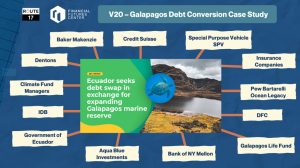Climate vulnerable countries, such as those in Latin America and the Caribbean, are currently locked in a cycle of debt and climate: extreme weather events are driving up debt burdens, shrinking already-limited fiscal space and leading to higher costs of capital. Governments are left unable to adequately invest in adaptation measures or meet nationally determined contributions (NDCs), leading to increased losses and damages when disaster strikes.
How, then, can climate vulnerable countries both respond to climate impacts and invest in climate and development goals while maintaining fiscal stability?
A new technical paper by researchers at the United Nations Economic Commission for Latin America and the Caribbean (UN-ECLAC) assesses the potential impact of climate change on economic growth and fiscal accounts for six Central American and Caribbean countries: Barbados, Dominican Republic, El Salvador, Guatemala, Honduras and Saint Lucia (CAC6). This paper is the latest in a series of technical papers published by the Task Force on Climate, Development and the IMF, a global consortium seeking to advance a development-centered approach to integrating climate into operations at the IMF.
The researchers illustrate existing economic barriers, estimate resource needs and outline policy recommendations for international financial institutions like the International Monetary Fund (IMF) to support investment in climate and development goals.
Main findings:
- Due to climate change, CAC6 countries may experience between 9 percent and 12 percent smaller gross domestic product (GDP) by 2050 compared to a trend growth scenario.
- Investment needs to compensate for climate impacts on economic growth are exceptionally large, ranging from 5.3 percent of GDP to 10.9 percent of GDP annually.
- While investments to achieve NDCs would limit economic losses, countries would also face worsening debt burdens. Public debt in Barbados, for example, would exceed 100 percent of GDP.
- As climate vulnerable countries face significantly higher borrowing costs, the cost of climate finance is a key driver of debt trajectories. NDC investments with concessional finance would soften debt burdens in five of six CAC6 countries.
- Concessional finance alone, however, cannot ensure long-term debt sustainability. Debt interest payments are a major barrier, with interest amounting to more than 30 percent of social spending for some CAC6 countries.
Policy recommendations:
- Debt relief is necessary for long-term debt sustainability for climate vulnerable countries. Concessional finance, while important, is not enough to bring down debt trajectories as countries invest in NDCs.
- A capital increase at multilateral and national development banks would provide more climate finance firepower. While these institutions have provided $11.5 billion per year in climate finance to the region between 2019-2020, it is insufficient to leverage the amount of private capital necessary to meet climate objectives.
- The IMF has a critical role to play in three ways:
- Scaling its lending toolkit, and in particular the Resilience and Sustainability Trust, with current need and calibrating it to support an investment-led approach to a low-carbon transition.
- Providing technical assistance to build long-term, socially oriented investment strategies as countries navigate their low-carbon transitions.
- Bolstering surveillance activities by moving beyond carbon pricing in its Article IV reports and implementing a suite of climate policy instruments that match unique country macroeconomic contexts.
CAC6, and other climate vulnerable countries, face not only a climate crisis but also a development crisis. To combat limited fiscal space and tremendous resource needs, concessional finance must be paired with debt relief and greater reform of international financial institutions to usher in socially just low-carbon transitions.




